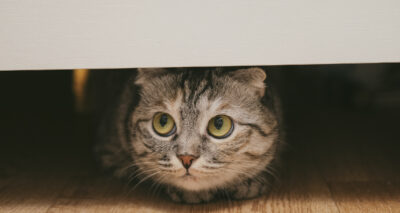Can Kittens Have Catnip?

Catnip has the power to induce euphoria, a pleasant calmness, and sometimes even playful aggression in the many cats who enjoy smelling, rolling on, or eating this natural herb.
A member of the mint family, catnip is related to basil and oregano. Sniffing tends to cause more excitement in cats while chewing the plant results in more sedation. Cats often rub on catnip products to release more of its essential oil to heighten their “high.”
While the majority of cats experience a pleasant response to catnip, approximately 30 percent are unaffected, largely due to genetics or personality nuances. Kittens, particularly those under 3 months of age, also lack a response.
So if kittens do not typically respond to catnip until they’re older, can they still be offered catnip? Is it safe? Let’s find out.
Can Kittens Have Catnip?

While catnip exposure is safe for kittens, kittens do not respond to the effects of catnip until they are at least 3 to 6 months old. Others may take as long as 9 to 12 months before responding to catnip.
Cats typically reach sexual maturity at 6 months of age. Prior to this, their brains are not yet developed enough to react to nepetalactone, the active ingredient in the catnip plant that mimics the scent of a female cat in heat. Spaying or neutering will not alter this response since the reaction tends to be based on brain maturity and not the presence of sex hormones.
So when can you give a kitten catnip? Pet parents may wish to introduce catnip to a kitten anytime between 3 to 6 months of age. If the kitten does not initially respond, try again each month until a response is elicited.
You might also be wondering how much catnip to give a kitten compared to an adult cat. While catnip is very safe, only a small amount (about the size of a half dollar) of fresh or dried catnip or a toy containing catnip is recommended for a kitten to sniff or chew. A little goes a long way.
Catnip for Kittens: Benefits and Risks

Once a kitten is old enough to respond to catnip, occasional use can be beneficial to reduce anxiety and boredom as well as provide your kitten a fun, pleasant sensation. Since this natural herb is non-addictive and non-toxic with no significant ill side effects, it is safe to offer to young kittens.
If your kitten experiences separation anxiety or is stressed during short car rides or vet visits, offering some fresh or dried catnip to consume can offer a calming effect to reduce anxiety.
Catnip also serves as a fantastic training tool for felines. You can offer it as a reward for good behaviors or when teaching new tricks. If your kitten is scratching inappropriate items like furniture, you can use catnip to redirect your cat by placing it on an appropriate item like a scratching post.
Kittens and adult cats cannot overdose on catnip, and consuming a small amount is safe so long as no pesticides were sprayed on the plant. However, eating too much can cause vomiting, diarrhea, and dizziness in some cats. Fortunately, most cats self-regulate well and do not tend to consume enough to the point of inducing gastrointestinal upset.
Secondary injuries may be sustained if a kitty becomes over excited while enjoying catnip and starts running around chaotically, potentially resulting in a fall or knocking something over. Thus, kittens should be supervised during catnip exposure.
Additionally, kittens with known preexisting seizure disorders should avoid use of catnip unless otherwise instructed by a veterinarian or veterinary neurologist. Catnip can potentially worsen seizures in cats who are already affected.
How to Give a Kitten Catnip

Our feline friends can become immune to the effects of catnip after a period of time, resulting in a two-hour refractory period. As such, do not grant constant exposure. Instead, introduce catnip for about 15 minutes two to three times a week to ensure your kitten will continue to enjoy the effects.
The most potent levels of nepetalactone are found in the leaves and delicate pale purple flowers of the catnip plant; lesser amounts are found in the stem and stalk. Therefore, offer your kitten products that feature more leaves or blossoms.
When choosing a product, you can look for raw amounts of the fresh or dried plant, sprays, tinctures, or toys.
You can grow the fresh catnip plant in a small pot inside your home or outdoors. Cats enjoy munching on either the fresh or dry plant. To dry it, hang the leaves, stems, and flowers upside down in a dark room and then freeze or store it in an airtight container once dry. This will help prevent the plant from becoming stale and losing its effect. Consuming the fresh or dry plant is the best option for helping reduce a kitten’s stress and anxiety.
Catnip sprays or tinctures that contain at least 50 percent or more essential oil of the catnip plant are helpful to use for training a kitten. You can spray or drizzle these products without causing a mess.
Catnip toys (such as toy mice, balls, or even an old sock stuffed with the herb) are the best option to offset a kitten’s boredom. Toys provide environmental enrichment, exercise, and elicit more of a fun, playful response in kittens. Common brands include Kong and Yeowww! Look for refillable products that allow you to top up the catnip. This will help prevent staleness without having to replace the entire item.
Ready to give a kitten catnip? Remember to start slow and see how your kitten responds!









